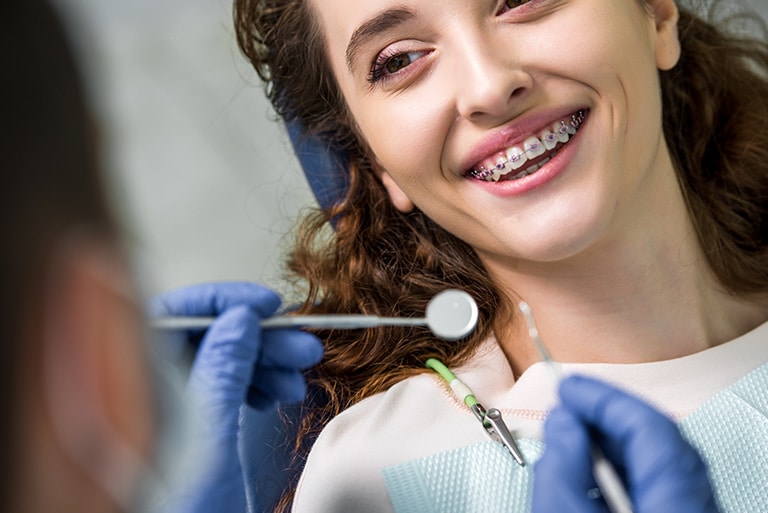Braces have long been a reliable solution for correcting teeth alignment and enhancing smiles. With advancements in dental technology, today’s braces offer more comfortable and discreet options for both children and adults. In this blog, we’ll dive into what teeth braces are, the different types available, and their benefits, helping you make an informed decision about your orthodontic care.
What Are Teeth Braces?
Braces are orthodontic devices used to correct misaligned teeth, improper bites, and other dental irregularities. They apply consistent pressure to gradually move teeth into the desired position over time. The result is a straighter smile and improved oral health.
Types of Teeth Braces
There are several types of braces available today, each with unique benefits:
1. Traditional Metal Braces
These are the most common type of braces, made from high-quality stainless steel. Metal braces use brackets and wires to shift teeth into position. While they are highly effective, they are also more noticeable than other types of braces.
Pros:
- Cost-effective
- Suitable for all ages
- Most effective for complex cases
Cons:
- Highly visible
- May cause slight discomfort initially
2. Ceramic Braces
Ceramic braces function similarly to metal braces but are made of clear or tooth-colored materials. This makes them less noticeable.
Pros:
- Less visible than metal braces
- Effective for moderate to severe alignment issues
Cons:
- More expensive than metal braces
- Prone to staining if not properly maintained
3. Lingual Braces
Lingual braces are placed behind the teeth, making them completely invisible from the outside. They work just like traditional braces but offer a more discreet option.
Pros:
- Invisible from the front
- Effective for complex cases
Cons:
- Can be uncomfortable initially
- May cause speech difficulties
- Higher cost compared to traditional braces
4. Invisalign
Invisalign is a popular alternative to traditional braces, consisting of clear, removable aligners that are custom-made for each patient. These aligners gradually shift the teeth into place without the need for metal brackets or wires.
Pros:
- Nearly invisible
- Removable for eating and cleaning
- Comfortable and convenient
Cons:
- Not suitable for severe cases
- Requires strict compliance for effectiveness
- More expensive than traditional braces
Benefits of Teeth Braces
Braces offer a range of benefits beyond just aesthetics. Here are some of the key advantages:
- Improved Smile: Braces correct misaligned teeth, giving you a straighter, more confident smile.
- Better Oral Health: Correcting teeth alignment can improve your ability to brush and floss, reducing the risk of cavities and gum disease.
- Corrects Bite Issues: Braces can fix overbites, underbites, and crossbites, which can prevent future jaw pain and wear on the teeth.
- Prevents Future Problems: Early intervention with braces can prevent more serious dental issues from developing later in life.
How Much Do Braces Cost?
The cost of teeth braces varies depending on the type and complexity of the case. On average, traditional metal braces can cost between $3,000 and $7,000. Ceramic braces range from $4,000 to $8,000, while lingual braces may cost upwards of $10,000. Invisalign treatment typically falls between $3,000 and $8,000.
Most dental insurance plans cover part of the cost, and many orthodontists offer flexible payment plans to make braces more affordable.
Conclusion
Teeth braces offer a proven solution for achieving a straighter, healthier smile. Whether you opt for traditional metal braces or a more discreet option like Invisalign, the benefits of orthodontic treatment are clear. Consult with your orthodontist to determine which type of braces is right for you, and take the first step toward a lifetime of better oral health.
Frequently Asked Question
What are the different types of teeth braces available?
There are several types of braces available today, each with unique benefits. These include traditional metal braces, ceramic braces, lingual braces, and Invisalign. Traditional metal braces are the most common and are made from high-quality stainless steel. Ceramic braces are similar to metal braces but are less visible as they blend with the natural color of your teeth. Lingual braces are placed behind the teeth, making them invisible from the front. Invisalign involves a series of clear, removable aligners that straighten teeth without the use of metal wires or brackets.
How do teeth braces work to correct alignment?
Teeth braces work by applying consistent pressure over time to move teeth into the desired position. This gradual movement corrects misalignments, improper bites, and other dental irregularities. The result is a straighter smile and improved oral health. The process involves adjustments made by an orthodontist to ensure that the teeth are moving correctly according to the treatment plan.
What are the benefits of using teeth braces?
The benefits of using teeth braces include improved teeth alignment, enhanced smile aesthetics, and better oral health. Correct alignment can make cleaning teeth easier, reducing the risk of cavities and gum disease. Properly aligned teeth can also improve bite function and reduce strain on the jaw muscles. Additionally, modern braces offer more comfortable and discreet options, making orthodontic treatment more accessible to both children and adults.


